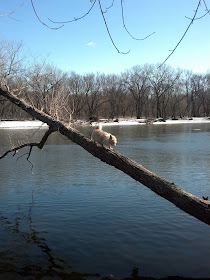As trainers, we make lots of choices.
We talk a lot about what behaviors we want to teach, and how we are
going to get those behaviors. We talk about our criteria, when to
raise it, and the best way to set a dog up for success. We talk about
how often and how long we should train. We talk about whether or not
we will choose to use punishment at any point in this process.
What we often overlook, though, is that
we aren’t the only one making choices. There are two living,
thinking beings involved in training, and it’s important to realize
that our dogs have “agency.” This means that they have the
ability to act independently and make their own choices. In fact, our
dogs encounter dozens of “choice points” every day, and Kathy
argues that we should not prevent them from making decisions when
they arise. If we do, our dogs might become overly dependent on us,
or worse yet, they might learn that their behavior doesn’t make a
difference in the world, which can lead to anxiety or learned
helplessness.
 |
| I let Maisy decide to explore this tree branch. |
So we need to let our dogs make
decisions. Because they live in a human world, most of us will train
our dogs so that they make decisions we like. This is really fairly
simple; all we need to do is notice when our dogs make choices and
reinforce the ones we like. As Kathy pointed out, we have to feed our
dogs anyway, so we might as well take advantage of it! Even better,
Kathy urged us to become “choice architects.” This fun term means
that finding clever ways to get our dogs to choose the option we
want.
Choice architects typically manipulate
the environment so that when a dog comes to a “choice point”- a
situation in which the trainer will allow him to make a decision- he
makes the correct decision. Sometimes this is done by making the
behavior that the dog prefers (and that trainer dislikes) harder for
him to do. Sometimes it’s done by making the choice that the
trainer would prefer easier for the dog. Often, it’s best to do a
combination of these; using just the first choice is often
inefficient or unsuccessful.
A choice architect will set things up
so that when the dog comes to a choice point between a good choice
and a bad one, the bad one is harder to engage in than the good one
is. A really good choice architect will not only create this
situation, but also pay close attention to the dog and
reinforce him as frequently and generously as possible when he makes
a good decision.
This is different from management; we
aren’t preventing bad behavior. Management effectively takes the
choice away from the dog so that the trainer is the only one making
decisions. And while it’s important to allow dogs to learn that
their choices and their behavior matters, management does have a
place in training.
For example, untreated, my dog’s
anxiety and reactivity could have become dangerous; she threatened to
bite children on several occasions. I used management to prevent her
from doing so. At the same time, I set up very controlled situations
(read: safe) so that Maisy could learn to make good decisions when
she was feeling scared or anxious.
Over the years, Maisy has gone from
heavily managed to being allowed to make many decisions on her own.
Because I built these new skills up slowly, gradually generalizing
them to more and more difficult situations, she was able to develop
confidence her in ability to make good decisions. These days, I allow
her a lot of latitude; I will ask if she wants to meet someone or
not, which direction she wants to go on walks, and what she wants to
eat at mealtimes. I am a choice architect.
But I’m getting off-topic. Kathy was
talking about training in general, not the specifics of working with
reactive dogs. That’s just my area of interest! Anyway, reactive or
not, how do you act as a choice architect? What do you do to make the
behaviors you want from your dog the most attractive option?

No comments:
Post a Comment
I suck at replying to comments. I suck less at responding on the Facebook Fan Page and emails. Just so you know.